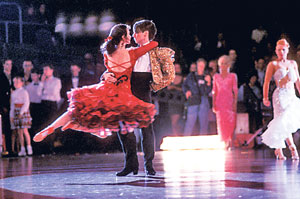Strictly Ballroom (Baz Luhrmann, 1992): Australia
Reviewed by Lauren Sousa. Viewed on DVD.

There is a makeover in this movie. Alas, the movie makeover is a classic coming-of-age trope that so few can attempt and survive. This one does. How? By ignoring it.
Strictly Ballroom, writer-director Baz Luhrmann’s directorial debut, is set in the madcap world of competitive ballroom dancing and is based on a hit play that he produced in the 1980’s. As a result, the costumes are loud and wild enough to be seen in the back row of even the largest theater, though it’s questionable whether the makeup was as lavish when most of the audience didn’t have the advantage of the close-up. The plot is almost unbelievably predictable: Scott Hastings (Paul Mercurio), a competitive ballroom dancer of indeterminate age still living at home and practicing at his parents’ dance studio, is tired of dancing “strictly ballroom,” the classic steps approved by the dance federation. After going rogue at a competition, his partner leaves him, but gawky, inexperienced dancer Fran (Tara Morice) realizes that dancing and having fun are much more important than following the rules and winning the Pan Pacific Grand Prix.
As soon as Fran asks Scott to dance with her, the entire plot has been revealed. You already know who gets the makeover. You already know who wins. Two of the many things that this movie does right, though, is that you’re right both times, except that you aren’t. The makeover is simply gradual, resulting from Fran’s growing self-confidence at dancing, familial support, some vaguely referenced “apricot scrub” and “buff puff,” and, yes, more attractive clothes, but it’s handled very well; she’s poor, and her costume reflects that. There’s one blink-and-you’ll-miss-it scene where she’s made up like the other girls, but it’s presented as ridiculous, and she returns to her normal, bare-faced persona
In short, Fran is different. She’s not like those other girls – and Scott’s not like those other boys, who are presented as either drunk and distracted or focused on nothing but ballroom. It’s a simple device, but it works – Scott and Fran’s relative normalcy and Fran’s inexperience make them effective conduits for the audience. The ridiculous costumes and makeup of most of the dancers, which involves face jewels, ruffled sleeves, sequins, fake tans and bleach-blonde hair, contrasts sharply with Scott and Fran’s normal costumes, which allows the audience to feel, along with their surrogates, removed from those ridiculous, often ego-maniacal characters that fill out the minor cast.
It succeeds both as a ridiculous drama and all-out comedy; it’s predictable, but it’s funny and well-shot. Further, it’s unusual; yes, once the goals have been set up, the conflicts are only requisite. This is the type of movie where a happy ending is perfectly obvious from the inciting event, but it’s also the type of movie that actually manages to make you care about the characters; even in a world that has experienced Dancing with the Stars, the cutthroat world of ballroom dancing is still all but foreign to most of us, and it’s fascinating to watch characters who really, really care about something so frivolous and fun face and overcome perfunctory obstacles in a bright-colored world. Alas, Mercurio’s acting isn’t perfect, but his expertise is dancing, not acting, and his performance is serviceable, as are all of the others. The film’s strongest aspect, though, is those dance scenes; there aren’t many long takes or elaborate set pieces, but the cutting, music, and choreography all come together well, both aesthetically and as support to the plot; it’s worth it, though, just to laugh at those dancers.
7 Comments
Jump to comment form | comments rss [?] | trackback uri [?]